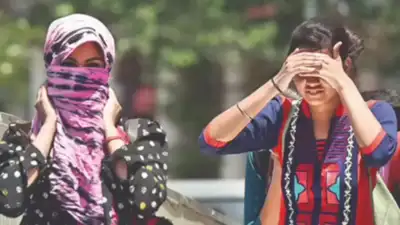After wet May, searing heatwave, a result of how climate change modifying weather systems | India News

Bathinda: After large excess rains in North India in the month of May, the month of June has begun on an intensely hot note, with large parts reeling under a severe heatwave. While heatwave spells before the monsoon are not unusual, the scale and severity of this year’s conditions once again bring global warming into sharp focus. Experts are increasingly pointing to climate change as a major driver behind the rising frequency, intensity, and changing geography of heatwaves across the country. The added spike in humidity levels has only deepened public discomfort, posing serious risks, particularly to vulnerable communities, finds Climate Trends, a research consultancy, in its note on changing heatwave patterns. Day temperatures have been skyrocketing since the first week of June, with mercury settling past 44°C mark across Punjab, Haryana, Rajasthan and Delhi. India Meteorological Department (IMD) has been issuing red alert for five straight days since June 9 as before that heatwave spells were confined to Rajasthan. The primary reason for missing heatwaves this season were on-and-off spells of rain and thundershowers across Indo-Gangetic Plains. In fact, Punjab, Haryana and Delhi witnessed one of the wettest May. “Monsoon had advanced almost a week before its time, however, after reaching Mumbai and many parts of Northeast India, the progress stalled, and the frequency of western disturbances also reduced significantly. In the last week, we have seen that cyclonic circulations over Northwest India were very weak and there has been a continuous flow of hot and dry winds over the Indo-Gangetic plains. The heat is being transported from the Thar desert, where temperatures have already been settling near 48°C, reaching up to eastern and central parts of the country. The continuous flow of these dry north-westerly winds is also not allowing the Monsoon further,” said Mahesh Palawat, Vice President- Meteorology and Climate Change, Skymet Weather. The searing heatwave became even more uncomfortable with the rise in humidity. This does not just increase discomfort but also poses a challenge to the health infrastructure. A prolonged exposure to extreme temperatures along with high humidity levels often causes heat strokes, mainly impacting the poor, outdoor workers, children, and the elderly. According to experts, the ongoing weather conditions are directly related to the impact of global warming. Climate change has increased the variability of extreme weather events, especially heatwave over India. “Northwest India remains susceptible to heatwaves until the monsoon arrives over the region. There is no doubt that climate change has led to increased severity of heatwaves across the region. Humidity is another troubling factor that has become more prominent due to global warming. A slight increase in humidity levels adds 2-4°C, increasing discomfort. Morbidity has also risen because of these combined factors. The northern plains were used to dry weather conditions; however, they now struggle with humid weather conditions. With the rise of every one degree of warming, the capacity of the air to hold water vapour has increased by 7%. All the hilly states have seen two to four degrees of warming,” said KJ Ramesh, former director general, IMD. The observed migration of heatwave occurrences at places previously less susceptible is a clear signal of the broadening climate crisis. The time series of heatwave events over the last three decades reveals an increase in heatwave occurrences over the years. According to a latest study on heatwaves, ‘Shifting of the Zone of Occurrence of Extreme Weather Event—Heat Waves’, it has been observed that heatwave instances over North India (Punjab, Haryana, Delhi, Himachal Pradesh, Uttarakhand) increased every 10 years from 1991-2020. Locations of heatwave were concentrated in central India during 2001-2010 that appeared to shift towards the Southern region during 2011-2020. Further analysing the occurrences of severe heatwave events over India in the past three decades in June, there was a notable increase in hot weather conditions across the northwestern to central regions of India. Additionally, these conditions extended to hilly states such as Jammu and Kashmir, Himachal Pradesh, Uttarakhand and certain areas of the Union Territory of Ladakh. It has been observed that heatwave events are on the rise, particularly from 1971 up to the last decade in the northeastern states. The last two decades marked the beginning of an even warmer global climate. The reason behind this adversity can be traced to the synoptic conditions associated with prevailing high temperatures, particularly instances of north– south wind discontinuity and the recurring cyclonic storms over the Bay of Bengal towards the east. These events disrupt the pressure distribution system followed by the movement of the north-south trough towards the sea, resulting in the cut-off of sea breeze and also strengthening the intense pressure system, causing persistent high temperatures leading to heatwaves.




